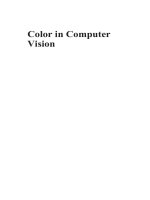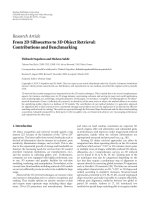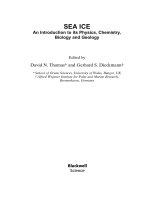an intro to 3d computer vision techniques and algorithms
Bạn đang xem bản rút gọn của tài liệu. Xem và tải ngay bản đầy đủ của tài liệu tại đây (10.39 MB, 502 trang )
OTE/SPH OTE/SPH
fm JWBK288-Cyganek December 4, 2008 22:54 Printer Name: Yet to Come
AN INTRODUCTION
TO 3D COMPUTER
VISION TECHNIQUES
AND ALGORITHMS
i
An Introduction to 3D Computer Vision Techniques and Algorithms Bogusław Cyganek and J. Paul Siebert
C
2009 John Wiley & Sons, Ltd. ISBN: 978-0-470-01704-3
OTE/SPH OTE/SPH
fm JWBK288-Cyganek December 4, 2008 22:54 Printer Name: Yet to Come
AN INTRODUCTION
TO 3D COMPUTER
VISION TECHNIQUES
AND ALGORITHMS
Bogusław Cyganek
Department of Electronics, AGH University of Science and Technology, Poland
J. Paul Siebert
Department of Computing Science, University of Glasgow, Scotland, UK
A John Wiley and Sons, Ltd., Publicatio
n
iii
OTE/SPH OTE/SPH
fm JWBK288-Cyganek December 4, 2008 22:54 Printer Name: Yet to Come
This edition first published 2009
C
2009 John Wiley & Sons, Ltd
Registered office
John Wiley & Sons Ltd, The Atrium, Southern Gate, Chichester, West Sussex, PO19 8SQ, United Kingdom
For details of our global editorial offices, for customer services and for information about how to apply for
permission to reuse the copyright material in this book please see our website at www.wiley.com.
The right of the author to be identified as the author of this work has been asserted in accordance with the
Copyright, Designs and Patents Act 1988.
All rights reserved. No part of this publication may be reproduced, stored in a retrieval system, or transmitted, in
any form or by any means, electronic, mechanical, photocopying, recording or otherwise, except as permitted by
the UK Copyright, Designs and Patents Act 1988, without the prior permission of the publisher.
Wiley also publishes its books in a variety of electronic formats. Some content that appears in print may not be
available in electronic books.
Designations used by companies to distinguish their products are often claimed as trademarks. All brand names and
product names used in this book are trade names, service marks, trademarks or registered trademarks of their
respective owners. The publisher is not associated with any product or vendor mentioned in this book. This
publication is designed to provide accurate and authoritative information in regard to the subject matter covered. It
is sold on the understanding that the publisher is not engaged in rendering professional services. If professional
advice or other expert assistance is required, the services of a competent professional should be sought.
Library of Congress Cataloging-in-Publication Data
Cyganek, Boguslaw.
An introduction to 3D computer vision techniques and algorithms / by Boguslaw
Cyganek and J. Paul Siebert.
p. cm.
Includes index.
ISBN 978-0-470-01704-3 (cloth)
1. Computer vision. 2. Three-dimensional imaging. 3. Computer algorithms. I. Siebert,
J. Paul. II. Title
TA1634.C94 2008
006.3
7–dc22
2008032205
A catalogue record for this book is available from the British Library.
ISBN 978-0-470-01704-3
Set in 10/12pt Times by Aptara Inc., New Delhi, India.
Printed in Great Britain by CPI Antony Rowe, Chippenham, Wiltshire
iv
OTE/SPH OTE/SPH
fm JWBK288-Cyganek December 4, 2008 22:54 Printer Name: Yet to Come
To Magda, Nadia and Kamil
From Bogusław
To Sabina, Konrad and Gustav
From Paul
v
OTE/SPH OTE/SPH
fm JWBK288-Cyganek December 4, 2008 22:54 Printer Name: Yet to Come
Contents
Preface xv
Acknowledgements xvii
Notation and Abbreviations xix
Part I 1
1 Introduction 3
1.1 Stereo-pair Images and Depth Perception 4
1.2 3D Vision Systems 4
1.3 3D Vision Applications 5
1.4 Contents Overview: The 3D Vision Task in Stages 6
2 Brief History of Research on Vision 9
2.1 Abstract 9
2.2 Retrospective of Vision Research 9
2.3 Closure 14
2.3.1 Further Reading 14
Part II 15
3 2D and 3D Vision Formation 17
3.1 Abstract 17
3.2 Human Visual System 18
3.3 Geometry and Acquisition of a Single Image 23
3.3.1 Projective Transformation 24
3.3.2 Simple Camera System: the Pin-hole Model 24
3.3.2.1 Extrinsic Parameters 26
3.3.2.2 Intrinsic Parameters 27
3.3.3 Projective Transformation of the Pin-hole Camera 28
3.3.4 Special Camera Setups 29
3.3.5 Parameters of Real Camera Systems 30
vii
OTE/SPH OTE/SPH
fm JWBK288-Cyganek December 4, 2008 22:54 Printer Name: Yet to Come
viii Contents
3.4 Stereoscopic Acquisition Systems 31
3.4.1 Epipolar Geometry 31
3.4.1.1 Fundamental Matrix 34
3.4.1.2 Epipolar Lines and Epipoles 35
3.4.2 Canonical Stereoscopic System 36
3.4.3 Disparity in the General Case 38
3.4.4 Bifocal, Trifocal and Multifocal Tensors 39
3.4.5 Finding the Essential and Fundamental Matrices 41
3.4.5.1 Point Normalization for the Linear Method 44
3.4.5.2 Computing F in Practice 46
3.4.6 Dealing with Outliers 49
3.4.7 Catadioptric Stereo Systems 54
3.4.8 Image Rectification 55
3.4.9 Depth Resolution in Stereo Setups 59
3.4.10 Stereo Images and Reference Data 61
3.5 Stereo Matching Constraints 66
3.6 Calibration of Cameras 70
3.6.1 Standard Calibration Methods 71
3.6.2 Photometric Calibration 73
3.6.3 Self-calibration 73
3.6.4 Calibration of the Stereo Setup 74
3.7 Practical Examples 75
3.7.1 Image Representation and Basic Structures 75
3.7.1.1 Computer Representation of Pixels 76
3.7.1.2 Representation of Images 78
3.7.1.3 Image Operations 87
3.8 Appendix: Derivation of the Pin-hole Camera Transformation 91
3.9 Closure 93
3.9.1 Further Reading 93
3.9.2 Problems and Exercises 94
4 Low-level Image Processing for Image Matching 95
4.1 Abstract 95
4.2 Basic Concepts 95
4.2.1 Convolution and Filtering 95
4.2.2 Filter Separability 97
4.3 Discrete Averaging 99
4.3.1 Gaussian Filter 100
4.3.2 Binomial Filter 101
4.3.2.1 Specification of the Binomial Filter 101
4.3.2.2 Spectral Properties of the Binomial Filter 102
4.4 Discrete Differentiation 105
4.4.1 Optimized Differentiating Filters 105
4.4.2 Savitzky–Golay Filters 108
4.4.2.1 Generation of Savitzky–Golay Filter Coefficients 114
OTE/SPH OTE/SPH
fm JWBK288-Cyganek December 4, 2008 22:54 Printer Name: Yet to Come
Contents ix
4.5 Edge Detection 115
4.5.1 Edges from Signal Gradient 117
4.5.2 Edges from the Savitzky–Golay Filter 119
4.5.3 Laplacian of Gaussian 120
4.5.4 Difference of Gaussians 126
4.5.5 Morphological Edge Detector 127
4.6 Structural Tensor 127
4.6.1 Locally Oriented Neighbourhoods in Images 128
4.6.1.1 Local Neighbourhood with Orientation 130
4.6.1.2 Definition of a Local Neighbourhood of Pixels 130
4.6.2 Tensor Representation of Local Neighbourhoods 133
4.6.2.1 2D Structural Tensor 136
4.6.2.2 Computation of the Structural Tensor 140
4.6.3 Multichannel Image Processing with Structural Tensor 143
4.7 Corner Detection 144
4.7.1 The Most Common Corner Detectors 144
4.7.2 Corner Detection with the Structural Tensor 149
4.8 Practical Examples 151
4.8.1 C++ Implementations 151
4.8.1.1 Convolution 151
4.8.1.2 Implementing the Structural Tensor 155
4.8.2 Implementation of the Morphological Operators 157
4.8.3 Examples in Matlab: Computation of the SVD 161
4.9 Closure 162
4.9.1 Further Reading 163
4.9.2 Problems and Exercises 163
5 Scale-space Vision 165
5.1 Abstract 165
5.2 Basic Concepts 165
5.2.1 Context 165
5.2.2 Image Scale 166
5.2.3 Image Matching Over Scale 166
5.3 Constructing a Scale-space 168
5.3.1 Gaussian Scale-space 168
5.3.2 Differential Scale-space 170
5.4 Multi-resolution Pyramids 172
5.4.1 Introducing Multi-resolution Pyramids 172
5.4.2 How to Build Pyramids 175
5.4.3 Constructing Regular Gaussian Pyramids 175
5.4.4 Laplacian of Gaussian Pyramids 177
5.4.5 Expanding Pyramid Levels 178
5.4.6 Semi-pyramids 179
5.5 Practical Examples 181
5.5.1 C++ Examples 181
5.5.1.1 Building the Laplacian and Gaussian Pyramids in C++ 181
OTE/SPH OTE/SPH
fm JWBK288-Cyganek December 4, 2008 22:54 Printer Name: Yet to Come
x Contents
5.5.2 Matlab Examples 186
5.5.2.1 Building the Gaussian Pyramid in Matlab 190
5.5.2.2 Building the Laplacian of Gaussians Pyramid in Matlab 190
5.6 Closure 191
5.6.1 Chapter Summary 191
5.6.2 Further Reading 191
5.6.3 Problems and Exercises 192
6 Image Matching Algorithms 193
6.1 Abstract 193
6.2 Basic Concepts 193
6.3 Match Measures 194
6.3.1 Distances of Image Regions 194
6.3.2 Matching Distances for Bit Strings 198
6.3.3 Matching Distances for Multichannel Images 199
6.3.3.1 Statistical Distances 201
6.3.4 Measures Based on Theory of Information 202
6.3.5 Histogram Matching 205
6.3.6 Efficient Computations of Distances 206
6.3.7 Nonparametric Image Transformations 209
6.3.7.1 Reduced Census Coding 212
6.3.7.2 Sparse Census Relations 214
6.3.7.3 Fuzzy Relationships Among Pixels 215
6.3.7.4 Implementation of Nonparametric Image
Transformations 216
6.3.8 Log-polar Transformation for Image Matching 218
6.4 Computational Aspects of Matching 222
6.4.1 Occlusions 222
6.4.2 Disparity Estimation with Subpixel Accuracy 224
6.4.3 Evaluation Methods for Stereo Algorithms 226
6.5 Diversity of Stereo Matching Methods 229
6.5.1 Structure of Stereo Matching Algorithms 233
6.5.1.1 Aggregation of the Cost Values 234
6.5.1.2 Computation of the Disparity Map 235
6.5.1.3 Disparity Map Postprocessing 237
6.6 Area-based Matching 238
6.6.1 Basic Search Approach 239
6.6.2 Interpreting Match Cost 241
6.6.3 Point-oriented Implementation 245
6.6.4 Disparity-oriented Implementation 250
6.6.5 Complexity of Area-based Matching 256
6.6.6 Disparity Map Cross-checking 257
6.6.7 Area-based Matching in Practice 259
6.6.7.1 Intensity Matching 260
6.6.7.2 Area-based Matching in Nonparametric Image Space 260
6.6.7.3 Area-based Matching with the Structural Tensor 262
OTE/SPH OTE/SPH
fm JWBK288-Cyganek December 4, 2008 22:54 Printer Name: Yet to Come
Contents xi
6.7 Area-based Elastic Matching 273
6.7.1 Elastic Matching at a Single Scale 273
6.7.1.1 Disparity Match Range 274
6.7.1.2 Search and Subpixel Disparity Estimation 275
6.7.2 Elastic Matching Concept 278
6.7.3 Scale-based Search 280
6.7.4 Coarse-to-fine Matching Over Scale 283
6.7.5 Scale Subdivision 284
6.7.6 Confidence Over Scale 285
6.7.7 Final Multi-resolution Matcher 286
6.8 Feature-based Image Matching 288
6.8.1 Zero-crossing Matching 289
6.8.2 Corner-based Matching 292
6.8.3 Edge-based Matching: The Shirai Method 295
6.9 Gradient-based Matching 296
6.10 Method of Dynamic Programming 298
6.10.1 Dynamic Programming Formulation of the
Stereo Problem 301
6.11 Graph Cut Approach 306
6.11.1 Graph Cut Algorithm 306
6.11.1.1 Graphs in Computer Vision 309
6.11.1.2 Optimization on Graphs 310
6.11.2 Stereo as a Voxel Labelling Problem 311
6.11.3 Stereo as a Pixel Labelling Problem 312
6.12 Optical Flow 314
6.13 Practical Examples 318
6.13.1 Stereo Matching Hierarchy in C++ 318
6.13.2 Log-polar Transformation 319
6.14 Closure 321
6.14.1 Further Reading 321
6.14.2 Problems and Exercises 322
7 Space Reconstruction and Multiview Integration 323
7.1 Abstract 323
7.2 General 3D Reconstruction 323
7.2.1 Triangulation 324
7.2.2 Reconstruction up to a Scale 325
7.2.3 Reconstruction up to a Projective Transformation 327
7.3 Multiview Integration 329
7.3.1 Implicit Surfaces and Marching Cubes 330
7.3.1.1 Range Map Pre-segmentation 331
7.3.1.2 Volumetric Integration Algorithm Overview 332
7.3.1.3 Hole Filling 332
7.3.1.4 Marching Cubes 333
7.3.1.5 Implementation Considerations 338
7.3.2 Direct Mesh Integration 338
OTE/SPH OTE/SPH
fm JWBK288-Cyganek December 4, 2008 22:54 Printer Name: Yet to Come
xii Contents
7.4 Closure 342
7.4.1 Further Reading 342
8 Case Examples 343
8.1 Abstract 343
8.2 3D System for Vision-Impaired Persons 343
8.3 Face and Body Modelling 345
8.3.1 Development of Face and Body Capture Systems 345
8.3.2 Imaging Resolution, 3D Resolution and Implications for Applications 346
8.3.3 3D Capture and Analysis Pipeline for Constructing Virtual Humans 350
8.4 Clinical and Veterinary Applications 352
8.4.1 Development of 3D Clinical Photography 352
8.4.2 Clinical Requirements for 3D Imaging 353
8.4.3 Clinical Assessment Based on 3D Surface Anatomy 353
8.4.4 Extraction of Basic 3D Anatomic Measurements 354
8.4.5 Vector Field Surface Analysis by Means of Dense Correspondences 357
8.4.6 Eigenspace Methods 359
8.4.7 Clinical and Veterinary Examples 362
8.4.8 Multimodal 3D Imaging 367
8.5 Movie Restoration 370
8.6 Closure 374
8.6.1 Further Reading 374
Part III 375
9 Basics of the Projective Geometry 377
9.1 Abstract 377
9.2 Homogeneous Coordinates 377
9.3 Point, Line and the Rule of Duality 379
9.4 Point and Line at Infinity 380
9.5 Basics on Conics 382
9.5.1 Conics in ℘
2
382
9.5.1.1 The Dual Conic 383
9.5.1.2 Circular Points 383
9.5.2 Conics in ℘
2
384
9.5.2.1 The Absolute Conic 384
9.5.2.2 The Dual Absolute Conic 385
9.6 Group of Projective Transformations 385
9.6.1 Projective Base 385
9.6.2 Hyperplanes 386
9.6.3 Projective Homographies 386
9.7 Projective Invariants 387
9.8 Closure 388
9.8.1 Further Reading 389
OTE/SPH OTE/SPH
fm JWBK288-Cyganek December 4, 2008 22:54 Printer Name: Yet to Come
Contents xiii
10 Basics of Tensor Calculus for Image Processing 391
10.1 Abstract 391
10.2 Basic Concepts 391
10.2.1 Linear Operators 392
10.2.2 Change of Coordinate Systems: Jacobians 393
10.3 Change of a Base 394
10.4 Laws of Tensor Transformations 396
10.5 The Metric Tensor 397
10.5.1 Covariant and Contravariant Components in a Curvilinear
Coordinate System 397
10.5.2 The First Fundamental Form 399
10.6 Simple Tensor Algebra 399
10.6.1 Tensor Summation 399
10.6.2 Tensor Product 400
10.6.3 Contraction and Tensor Inner Product 400
10.6.4 Reduction to Principal Axes 400
10.6.5 Tensor Invariants 401
10.7 Closure 401
10.7.1 Further Reading 401
11 Distortions and Noise in Images 403
11.1 Abstract 403
11.2 Types and Models of Noise 403
11.3 Generating Noisy Test Images 405
11.4 Generating Random Numbers with Normal Distributions 407
11.5 Closure 408
11.5.1 Further Reading 408
12 Image Warping Procedures 409
12.1 Abstract 409
12.2 Architecture of the Warping System 409
12.3 Coordinate Transformation Module 410
12.3.1 Projective and Affine Transformations of a Plane 410
12.3.2 Polynomial Transformations 411
12.3.3 Generic Coordinates Mapping 412
12.4 Interpolation of Pixel Values 412
12.4.1 Bilinear Interpolation 412
12.4.2 Interpolation of Nonscalar-Valued Pixels 414
12.5 The Warp Engine 414
12.6 Software Model of the Warping Schemes 415
12.6.1 Coordinate Transformation Hierarchy 415
12.6.2 Interpolation Hierarchy 416
12.6.3 Image Warp Hierarchy 416
12.7 Warp Examples 419
12.8 Finding the Linear Transformation from Point Correspondences 420
12.8.1 Linear Algebra on Images 424
OTE/SPH OTE/SPH
fm JWBK288-Cyganek December 4, 2008 22:54 Printer Name: Yet to Come
xiv Contents
12.9 Closure 427
12.9.1 Further Reading 428
13 Programming Techniques for Image Processing and Computer Vision 429
13.1 Abstract 429
13.2 Useful Techniques and Methodology 430
13.2.1 Design and Implementation 430
13.2.1.1 Comments and Descriptions of ‘Ideas’ 430
13.2.1.2 Naming Conventions 431
13.2.1.3 Unified Modelling Language (UML) 431
13.2.2 Template Classes 436
13.2.2.1 Expression Templates 437
13.2.3 Asserting Code Correctness 438
13.2.3.1 Programming by Contract 438
13.2.4 Debugging Issues 440
13.3 Design Patterns 441
13.3.1 Template Function Objects 441
13.3.2 Handle-body or Bridge 442
13.3.3 Composite 445
13.3.4 Strategy 447
13.3.5 Class Policies and Traits 448
13.3.6 Singleton 450
13.3.7 Proxy 450
13.3.8 Factory Method 451
13.3.9 Prototype 452
13.4 Object Lifetime and Memory Management 453
13.5 Image Processing Platforms 455
13.5.1 Image Processing Libraries 455
13.5.2 Writing Software for Different Platforms 455
13.6 Closure 456
13.6.1 Further Reading 456
14 Image Processing Library 457
References 459
Index 475
OTE/SPH OTE/SPH
fm JWBK288-Cyganek December 4, 2008 22:54 Printer Name: Yet to Come
Preface
Recent decades have seen rapidly growing research inmany areasofcomputerscience,includ-
ing computer vision. This comes from the natural interest of researchers as well as demands
from industry and society for qualitatively new features to be afforded by computers. One es-
pecially desirable capability would be automatic reconstruction and analysis of the surround-
ing 3D environment and recognition of objects in that space. Effective 3D computer vision
methods and implementations would open new possibilities such as automatic navigation of
robots and vehicles, scene surveillance and monitoring (which allows automatic recognition
of unexpected behaviour of people or other objects, such as cars in everyday traffic), medical
reasoning, remote surgery and many, many more.
This book is a result of our long fascination with computers and vision algorithms. It started
many years ago as a set of short notes with the only purpose ‘to remember this or that’ or to
have a kind of ‘short reference’ just for ourselves. However, as this diary grew with the years
we decided to make it available to other people. We hope that it was a good decision! It is our
hope that this book facilitates access to this enthralling area, especially for students and young
researchers. Our intention is to provide a very concise, though as far as possible complete,
overview of the basic concepts of 2D and 3D computer vision. However, the best way to get
into the field is to try it oneself! Therefore, in parallel with explaining basic concepts, we
provide also a basic programming framework with the hope of making this process easier. We
greatly encourage the reader to take the next step and try the techniques in practice.
Bogusław Cyganek, Krak
´
ow, Poland
J. Paul Siebert, Glasgow, UK
xv
OTE/SPH OTE/SPH
fm JWBK288-Cyganek December 4, 2008 22:54 Printer Name: Yet to Come
Acknowledgements
We would like to express our gratitude to all the people who helped in the preparation of this
book!
In particular, we are indebted to the whole Wiley team who helped in the preparation of the
manuscript. In this group special thanks go to Simone Taylor who believed in this project and
made it happen. We would also like to express our gratitude to Sian Andrews, Laura Bell, Liz
Benson, Emily Bone, Lucy Bryan, Kate Griffiths, Wendy Hunter, Alex King, Erica Peters,
Kathryn Sharples, and Nicky Skinner.
We are also very grateful to the individuals and organizations who agreed to the use of
their figures in the book. These are Professor Yuichi Ohta from Tsukuba University, as well
as Professor Ryszard Szeliski from Microsoft Research. Likewise we would like to thank
Dimensional Imaging Ltd. and Precision 3D Ltd. for use of their images. In this respect we
would also like to express our gratitude to Springer Science and Business Media, IEEE Com-
puter Society Press, the IET, Emerald Publishing, the ACM, Maney Publishing and Elsevier
Science.
We would also like to thank numerous colleagues from the AGH University of Science and
Technology in Krak
´
ow. We owe a special debt of gratitude to Professor Ryszard Tadeusiewicz
and Professor Kazimierz Wiatr, as well as to Lidia Krawentek for their encouragement and
continuous support.
We would also like to thank members of the former Turing Institute in Glasgow (Dr Tim
Niblett, Joseph Jin, Dr Peter Mowforth, Dr Colin Urquhart and also Arthur van Hoff) as well
as members of the Computer Vision and Graphics Group in the Department of Computing
Science, University of Glasgow, for access to and use of their research material (Dr John Pat-
terson, Dr Paul Cockshott, Dr Xiangyang Ju, Dr Yijun Xiao, Dr Zhili Mao, Dr Zhifang Mao
(posthumously), Dr J.C Nebel, Dr Tim Boyling, Janet Bowman, Susanne Oehler, Stephen
Marshall, Don Whiteford and Colin McLaren). Similarly we would like to thank our col-
laborators in the Glasgow Dental Hospital and School (Professor Khursheed Moos, Professor
Ashraf Ayoub and Dr Balvinder Khambay), Canniesburn Plastic Surgery Unit (Mr Arup Ray),
Glasgow, the Department of Statistics (Professor Adrian Bowman and Dr Mitchum Bock),
Glasgow University, Professor Donald Hadley, Institute of Neurological Sciences, Southern
General Hospital, Glasgow, and also those colleagues formerly at the Silsoe Research Institute
(Dr Robin Tillett, Dr Nigel McFarlane and Dr Jerry Wu), Silsoe, UK.
Special thanks are due to Dr Sumitha Balasuriya for use of his Matlab codes and graphs.
Particular thanks are due to Professor “Keith” van Rijsbergen and Professor Ray Welland
without whose support much of the applied research we report would not have been possible.
xvii
OTE/SPH OTE/SPH
fm JWBK288-Cyganek December 4, 2008 22:54 Printer Name: Yet to Come
xviii Acknowledgements
We wish to express our special thanks and gratitude to Steve Brett from Pandora Inc. for
granting rights to access their software platform.
Some parts of the research for which results are provided in this book were possible due
to financial support of the European Commission under RACINE-S (IST-2001-37117) and
IP-RACINE (IST-2-511316-IP) as well as Polish funds for scientific research in 2007–2008.
Research described in these pages has also been funded by the UK DTI and the EPSRC
& BBSRC funding councils, the Chief Scientist Office (Scotland), Wellcome Trust, Smith’s
Charity, the Cleft Lip and Palate Association, the National Lottery (UK) and the Scottish
Office. Their support is greatly appreciated.
Finally, we would like to thank Magda and Sabina for their encouragement, patience and
understanding over the three-year period it took to write this book.
OTE/SPH OTE/SPH
fm JWBK288-Cyganek December 4, 2008 22:54 Printer Name: Yet to Come
Notation and Abbreviations
I
k
(x, y ) Intensity value of a k-th image at a point with local image coordinates
(x, y)
I
k
(x, y ) Average intensity value of a k-th image at a point with local image
coordinates ( x, y)
I Identity matrix; image treated as a matrix
P A vector (a point), matrix, tensor, etc.
T [I, P] The Census transformation T for a pixel P in the image I
i, j Free coordinates
d
x
, d
y
Displacements (offset) in the x and y directions
D(p
l
, p
r
) Disparity between points p
l
and p
r
D Disparity map (a matrix)
U(x, y) Local neighbourhood of pixels around a point (x, y)
O
c
Optical centre point
P
c
= [X
c
, Y
c
, Z
c
]
T
Coordinates of a 3D point in the camera coordinate system
Camera plane; a projective plane
o = (o
x
, o
y
) Central point of a camera plane
f Focus length of a camera
b Base line in a stereo system (a distance between cameras)
h
x
, h
y
Physical horizontal and vertical dimensions
of a pixel
P = [X, Y, Z]
T
3D point and its coordinates
℘
n
N-dimensional projective space
P = [X
h
, Y
h
, Z
h
,1]
T
Homogenous coordinates of a point
M Camera matrix
M
i
Intrinsic parameters of a camera
M
e
Extrinsic parameters of a camera
E Essential matrix.
F Fundamental matrix.
e
i
Epipole in an i-th image
SAD Sum of absolute differences
SSD Sum of squared differences
ZSAD Zero-mean sum of absolute differences
ZSSD Zero-mean sum of squared differences
ZSSD-N Zero-mean sum of squared differences, normalized
xix
OTE/SPH OTE/SPH
fm JWBK288-Cyganek December 4, 2008 22:54 Printer Name: Yet to Come
xx Notation and Abbreviations
SCP Sum of cross products
SCP-N Sum of cross products, normalized
RMS Root mean square
RMSE Root mean square error
<Lxx, Lyy> Code lines from a line Lxx to Lyy
HVS Human Visual System
SDK Software Development Kit
∧ logical ‘and’
∨ logical ‘or’
LRC Left-right checking (cross-checking)
OCC Occlusion constraint
ORD Point ordering constraint
BMD Bimodality rule
MGJ Match goodness jumps
NM Null method
GT RMS Ground-truth RMS
WTA Winner-takes-all
* Convolution operator
XYZ PQR
Colour-plates JWBK288-Cyganek December 4, 2008 7:31 Printer Name: Yet to Come
Plate 1 Perspective by Antonio Canal (1765, oil on canvas, Gallerie dell’ Accademia, Venice).
(See page 10)
1
An Introduction to 3D Computer Vision Techniques and Algorithms Bogusław Cyganek and J. Paul Siebert
C
2009 John Wiley & Sons, Ltd. ISBN: 978-0-470-01704-3
XYZ PQR
Colour-plates JWBK288-Cyganek December 4, 2008 7:31 Printer Name: Yet to Come
Plate 2 Painting by Bernardo Bellotto View of Warsaw from the Royal Palace (1773, Oil on canvas,
National Museum, Warsaw). (See page 11)
(a) (b)
Plate 3 Examples of the morphological gradient computed from the colour image (a, b).
(See page 128)
2
XYZ PQR
Colour-plates JWBK288-Cyganek December 4, 2008 7:31 Printer Name: Yet to Come
(a) (b)
Plate 4 (a) Binary image of a skewed rectangle and (b) colour visualization of its structural tensor –
hue H denotes a phase of local orientations, saturation S the coherence, and intensity I conveys trace of
T. (See page 142)
(
a
)(
b
)
Plate 5 (a) Monochrome image of a grid and (b) the colour visualization of its structural tensor.
(See page 142)
3
XYZ PQR
Colour-plates JWBK288-Cyganek December 4, 2008 7:31 Printer Name: Yet to Come
(a) (b) (c)
Plate 6 (a) Examples of the structural tensor operating on an RGB colour image. (b) Visualization
of the structural tensor computed with the 3-tap Simoncelli filter. (c) Version with the 5-tap Simoncelli
filter. (See page 145)
(
a
)(
b
)
Plate 7 “Kamil” image warped with the affine transformations: (a) the original RGB colour image,
(b) the output image after the affine transformation consisting of the -43
◦
rotation around a centre point,
scaling by [0.7, 0.8] and translation by the [155, 0] vector. (See page 423)
4
XYZ PQR
Colour-plates JWBK288-Cyganek December 4, 2008 7:31 Printer Name: Yet to Come
Plate 8 Eight dominant camera views of a skull. (See page 336)
Plate 9 Five views (four of these have been texture-pasted) of a single complete 3D skull model
computed by marching cubes integration of eight range surfaces. (See page 337)
5
XYZ PQR
Colour-plates JWBK288-Cyganek December 4, 2008 7:31 Printer Name: Yet to Come
Plate 10 Two views of the integrated skull model showing the colour-coded contributions from
different range maps. (See page 337)
Plate 11 Four rendered views of a 3D model captured by an experimental five-pod head scanner.
(Subject: His Excellency The Honourable Richard Alston, Australian High Commissioner to the United
Kingdom, 2005–2008). (See page 348)
6
XYZ PQR
Colour-plates JWBK288-Cyganek December 4, 2008 7:31 Printer Name: Yet to Come
Plate 12 Left: a generic mesh colour coded to label different anatomic regions of the face. Right:
the generic mesh conformed into the shape of a captured 3D face mesh, reproduced from [295]
(see page 359)
(a)
(b)
(c)
(d)
Plate 13 The result of the conformation process, using Mao’s basic method, reproduced from [296].
(a) The scanned model with 5 landmarks placed for the global mapping; (b) the generic model; (c) the
conformed generic model; reproduced from [295] (d) the scanned model aligned to the conformed
generic model: the red mesh is the conformed generic model, the yellow mesh is the scanned model.
(See page 358)
7









